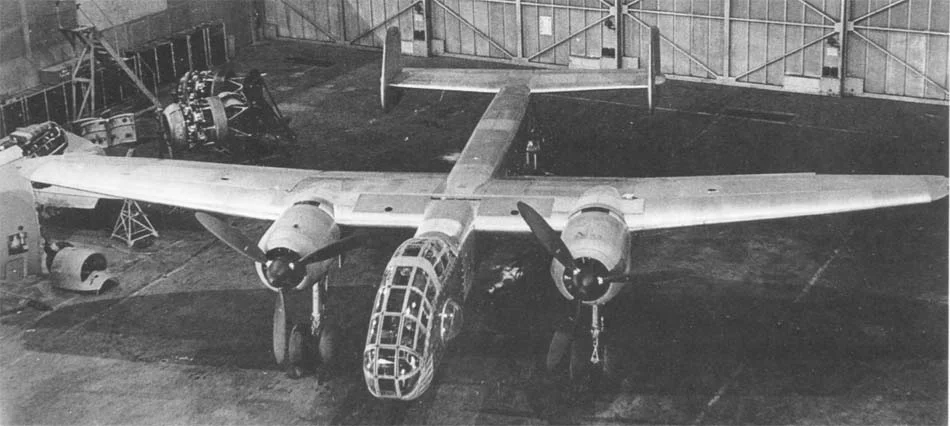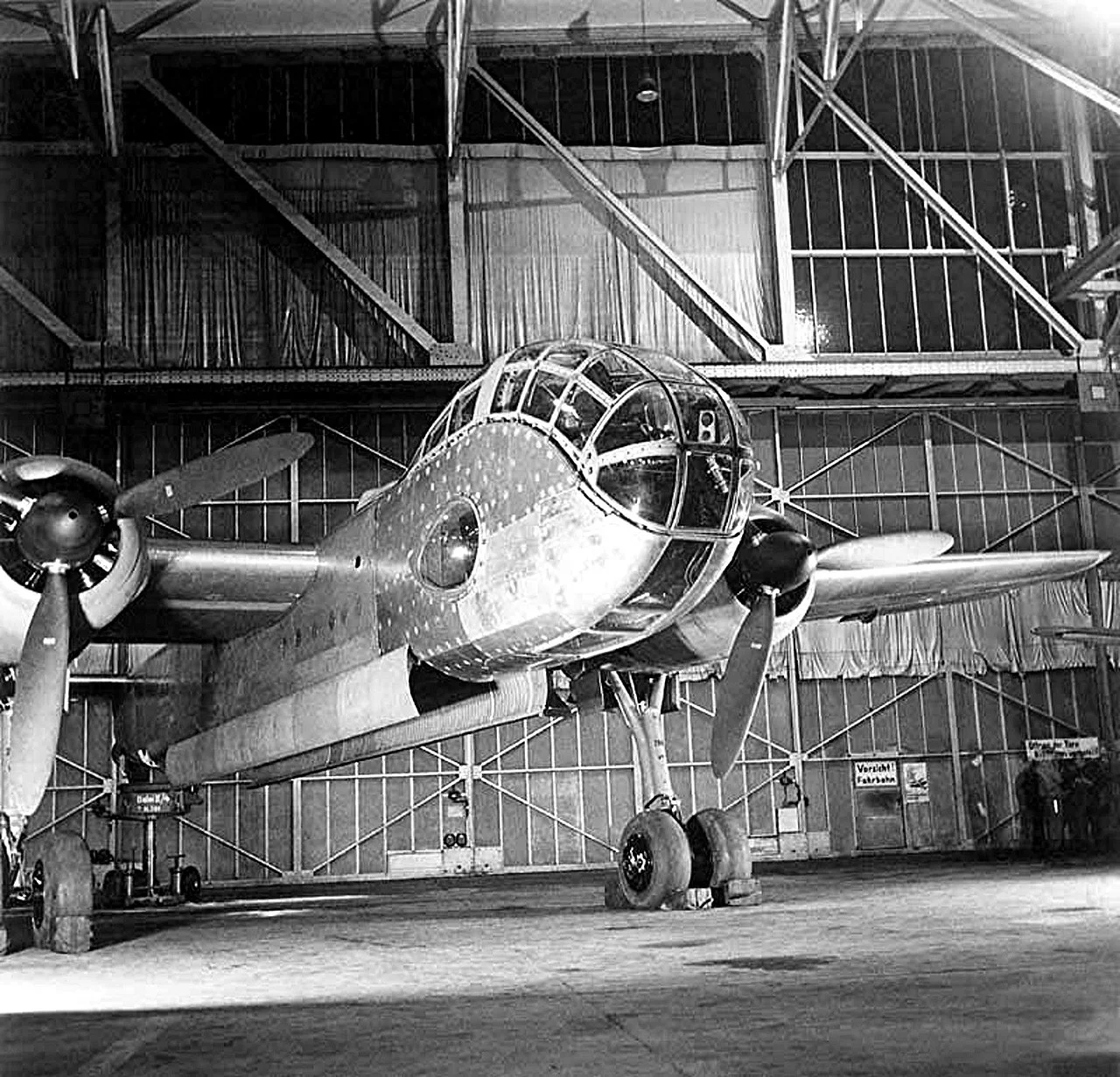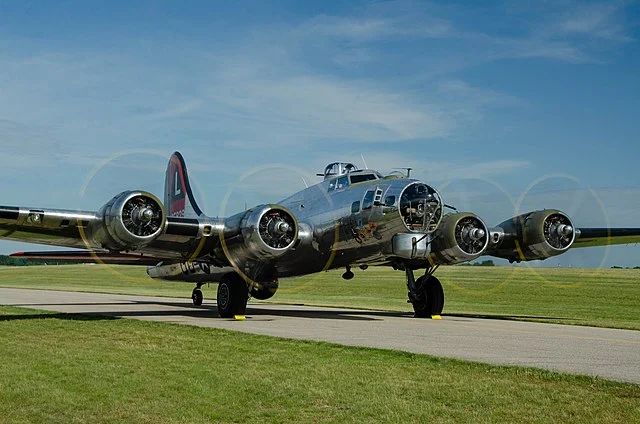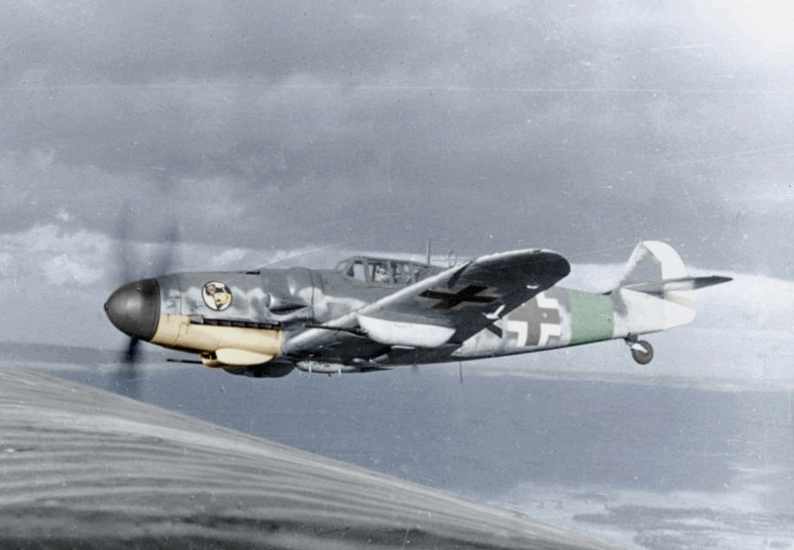The Ju 288 was developed as part of Germany’s Bomber B program during World War II. Before World War II began, the Luftwaffe’s bomber fleet mainly consisted of planes with modest capabilities, many of which were initially designed for civilian purposes.
The Ju 88 stood out as the only genuinely advanced model in their collection, surpassing other models in performance.
However, it faced several issues, one of the most significant being its tiny internal bomb bay. This limitation meant that part of its bomb load had to be carried on the outside, which hindered its speed and performance. Something new was needed.
Contents
Junkers as EF 074
The Junkers Ju 288, initially known within Junkers as EF 074, was a German bomber project developed during World War II, but it only saw action in prototype form. The first model took flight on November 29, 1940, with a total of 22 developmental units produced.
This aircraft emerged as the top choice in the Bomber B competition, a contest largely influenced by Junkers through their submission of the EF 074. The aim of the Bomber B initiative, which sought to replace the Junkers Ju 88, was to create a Schnellbomber, or fast bomber.

The Ju 288 presented a design that was not only larger but also featured cabin pressurization for high-altitude missions, extended range, a significantly larger bomb capacity, faster speeds, and enhanced defensive capabilities. It was envisioned as a replacement for all existing bombers in the Luftwaffe fleet.
Read More: The Junkers Ju 287 Had Backward Wings
To meet these ambitious specifications, the aircraft required much more potent engines. At various stages, all Bomber B designs depended on the Junkers Jumo 222 engine for this enhanced power. However, the Jumo 222 ultimately proved unsuccessful despite extensive efforts and multiple redesigns over several years, with nearly 300 prototypes developed.
No adequate alternative engine was found, leading to the downfall of the Ju 288 program and leaving the Luftwaffe to rely on older bomber models in the latter half of WW2
Ju 288 Background and Development
Before WW2 began, the Luftwaffe’s bomber fleet was comprised mainly of three types: the Dornier Do 17 and Ju 88, both categorized as schnellbomber or fast bombers, and the larger but slower Heinkel He 111.
The Ju 88 was superior in performance compared to other models in service, but it had its drawbacks, such as a very small internal bomb bay that necessitated carrying part of its bomb load externally, which reduced its efficiency.

Since 1937, Junkers had been developing improved versions of the Ju 88, equipped with the Jumo 222 multibank engine or the Jumo 223 inline multibank diesel engine.
Read More: BV 141 – The Asymmetrical Aircraft
These engines were designed to deliver a significant power output of 2,000 horsepower (1,500 kW), posing a considerable challenge to the German aviation engine industry at the time. The EF 074 was essentially an enlarged Ju 88, maintaining its basic structure but with extended fuselage and wings.
Dornier Do 217
It featured a redesigned, more aerodynamic “stepless cockpit” without separate windscreen panels for the pilot and co-pilot, facilitating easier cabin pressurization. This design became increasingly popular in German aircraft, notably seen in the He 111P and -H models.
The defensive armament of the aircraft was designed to be remotely controlled. One proposal, archived on April 13, 2014, in the Wayback Machine, included a remotely operated rear-facing dorsal turret at the end of the cockpit glazing, and two remotely operated flank turrets on the fuselage near the empennage, similar to the FDSL 131 units used in the Me 210.

The use of remotely operated turrets for the Ju 288’s defense not only allowed for more efficient positioning but also maintained the integrity of the fuselage pressurization.
To accommodate a significantly larger bomb payload, the fuselage was lengthened, similar to the modifications in the Dornier Do 217, which was under development at the time. This expansion enabled the aircraft to carry a 3,630 kg (8,000 lb) payload internally, eliminating the necessity for external ordnance hardpoints.
Design of Bomber B
Although preliminary designs existed, no substantial progress was made on these versions until Heinrich Hertel, previously with Heinkel, joined Junkers in 1939. Under his guidance, the EF 074 design was presented to the German Air Ministry (RLM) in May 1939.
Read More: The Caproni Ca.60 was a Nine Wing Cruise Liner
Subsequently, in July 1939, the RLM issued specifications for the Bomber B competition, retroactively designating the Ju 88 as Bomber A, a label previously assigned to the He 177 as per the 3 June 1936 specification. The Bomber B program sought to replace all medium bombers in the Luftwaffe with a new model based on the EF.74 or a comparable design.

This new bomber was expected to surpass the Ju 88 in speed, feature high-altitude capability with a pressurized cockpit, have heavier defensive armament, cover any target in the British Isles with its range, and carry a warload of 4,000 kg (8,820 lb), which was double that of earlier generation bombers.
24-Cylinder Jumo 222 Engines
Several companies submitted proposals for the Bomber B, but the EF.74 was already favored to win. Of the other designs, only the Focke-Wulf Fw 191, Dornier Do 317, and later the Henschel Hs 130 as a late entrant, progressed to the prototype stage.
Prototypes commenced construction soon afterward, with the first being completed by mid-1940. Initially, the plan was to power these aircraft with twin 24-cylinder Jumo 222 engines, each offering over 1,500 kW of output. However, developmental challenges with the Jumo 222 meant that the first prototypes were equipped with BMW 801 radial engines instead.

The first flight-worthy Jumo 222 engines were not available until October 1941, and even then, they were far from ready for mass production.
As it became evident that the Jumo 222 would not be a feasible engine option, Junkers proposed in May 1942 to use the heavier Daimler Benz DB 606 engines for the planned Ju 288C model. These were the same dual-crankcase engines that Reichsmarschall Hermann Göring criticized for their numerous issues, particularly in relation to the endless powerplant troubles of the He 177.

Undercarriage Difficulties
The design of the Ju 288’s main landing gear system was complex and problematic. It featured a unique arrangement where each gear unit had twin vertical elements forming a main “Y-shaped” retraction strut, situated behind a single oleo strut.
Read More: Fiat 7002: The Flying Drinks Cabinet
Each set of twin wheels was mounted on a forward-extending lever-action arm attached to the lower end of this distinct main oleo strut. This oleo strut, pivoting from the lower end of the “Y-shaped” retraction strut, would rotate backwards during the retraction process. This movement was independent of the twin-member unit and served to reduce the gear’s length when stowed in the engine nacelle.

The top end of the oleo strut, which moved freely, had to rotate downwards and backwards during the retraction of the main “Y-shaped” strut. This movement was controlled by a lever and gear-sector system located on the port side of each main gear assembly.
Firewall
The system, which was operated by a long lever pivoted from a bracket attached to the firewall’s rear surface, swung the oleo strut around its attachment point during retraction, moving it through an arc of approximately 180 degrees from its fully extended position.

In the stowed position, the oleo strut was oriented backwards within the rear of the engine nacelle, with the wheel axle situated just ahead of and above the oleo strut’s pivot point when fully retracted. This complicated design, with only a single pivoting point for the oleo struts bearing the primary impact of touchdown, was likely one of several issues that caused the Ju 288’s main gear units to repeatedly fail upon landing.
Ju 288 Program Cancellation
The cancellation of the Junkers Ju 288 program was a significant decision, marked by a combination of technical difficulties and shifting priorities during World War II. Initially envisioned as a state-of-the-art medium bomber under the ambitious Bomber B program, the Ju 288 was plagued with persistent technical challenges, the most notable being its engine.

The intended Jumo 222 engines, which were crucial for achieving the aircraft’s desired performance, faced continuous developmental hurdles. These engines, designed to provide superior power and efficiency, consistently failed to meet expectations, leading to delays and under performance in prototype testing.
Read More: The A.W.52 was Britain’s attempt at a Flying Wing
As the war progressed, the Luftwaffe’s needs and strategic focus shifted. The prolonged development and the inability to resolve the Ju 288’s technical issues meant that resources allocated to the project were increasingly seen as unjustifiable, especially in the face of more immediate wartime demands.
German aircraft production was under significant pressure, and priorities were given to projects that could be quickly realized and had immediate combat relevance.
Disappointment of Ju 288
In addition to the engine problems, the Ju 288 also struggled with other design complexities, such as its intricate and problematic landing gear system. These technical difficulties compounded the delays and escalated the costs of the project. By 1943, it became clear that the Ju 288 was not going to meet its objectives within a reasonable timeframe or budget.
Consequently, the RLM (Reich Air Ministry) made the decision to terminate the Ju 288 program. This cancellation was part of a broader rationalization of Germany’s aircraft production efforts, which aimed to concentrate resources on a smaller number of aircraft types that could be more reliably produced and deployed.
Read More: ‘Flying Pubs’ Spitfires Flew Beer to Normandy
The discontinuation of the Ju 288 program allowed the Luftwaffe to redirect its finite resources to other projects, particularly those that promised more immediate returns for the war effort. Thus, the Ju 288, which had promised much as a next-generation bomber, ended its journey as an experimental prototype, never realizing its intended role in the Luftwaffe’s arsenal.
Ju 288 Post-War Analysis
In the post-war period, the Junkers Ju 288, despite its failure to reach operational status during World War II, garnered interest for the advanced concepts and technologies it had introduced.

Allied forces, particularly the United States and the Soviet Union, were keen on examining German wartime aviation technology to glean insights that could be applied to their own aircraft development programs. The Ju 288, with its innovative design elements, was part of this scrutiny.
One of the key aspects of interest in the Ju 288 was its advanced aerodynamic design. The aircraft featured a streamlined, “stepless cockpit” design, which was a relatively new concept at the time, offering improved aerodynamics and visibility.
Read More: Weird He 119 Carried its Crew Inside the Nose
This design approach was later seen in various post-war aircraft designs. The Ju 288’s attempt at incorporating a pressurized cabin for high-altitude operation was another point of study, as it was a significant step towards developing aircraft capable of operating effectively at higher altitudes.
The aircraft’s complex and ambitious engineering, particularly its powerplant and landing gear system, were also subjects of analysis.
Ju 288 the Lessons Learned
Although these systems had proven problematic and contributed to the project’s cancellation, they represented forward-thinking engineering that pushed the boundaries of existing technology. Lessons learned from these systems’ shortcomings informed future aircraft design and development, helping to avoid similar pitfalls.
Moreover, the remote-controlled defensive armament system of the Ju 288 was a noteworthy feature. This system was an early attempt at reducing drag and improving defensive capabilities without compromising aerodynamic efficiency. Such concepts were instrumental in the evolution of turret design in later aircraft.
While the Ju 288 itself did not make a direct impact on the war, the data and insights gained from its development contributed to post-war aviation technology.
The examination of its design and systems provided valuable lessons for future aircraft development, influencing the design of both military and civilian aircraft in the ensuing decades. The Ju 288’s legacy, therefore, lies in its role as a stepping stone in the advancement of aviation technology, illustrating both the ambition and the challenges of aerospace engineering during a pivotal era in history.








